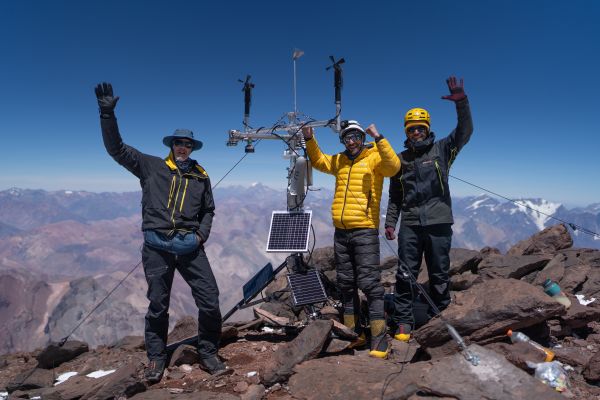04-08-2025

LOGAN, UTAH — In coordination with Campbell Scientific, Dr. Baker Perry has successfully installed a series of weather stations along Aconcagua with the hopes of bringing valuable water and weather data to Argentinians and the global climate community.
Water Measurements at
the Extremes
Campbell Scientific, a global leader in environmental measurement solutions, has once again partnered with renowned climate scientist Dr. Baker Perry of the University of Nevada, Reno to install a high-altitude automatic weather station—this time on Aconcagua, the tallest mountain in the Western Hemisphere.
The expedition—co-led by Dr. Tom Matthews from King’s College London and Dr. Perry and in conjunction with Dr. Pierre Pitte from the Instituto Argentino de Nivología, Glaciología y Ciencias Ambientales (IANIGLA)—is part of an ongoing quest to better understand the impacts of water supply and weather on high-mountain regions. On their journey, the group of climate scientists installed a total of four new weather stations on Aconcagua in the Central Andes and relocated an existing flux station.
The new summit station, elevation 6,000 meters (approximately 19,700 feet), is the highest automatic weather station in South America. It will deliver real-time data on critical atmospheric and climate variables, such as temperature, relative humidity, wind speed and direction, liquid precipitation, and snow.
This latest collaboration builds on the successful 2019 installation of the world’s highest weather station on Mount Everest—a joint effort between Dr. Perry, Campbell Scientific, and other collaborators. The Everest station set a global benchmark for high-elevation data collection, and now the Aconcagua station extends that legacy to the Andes.
“At Campbell Scientific, our mission is to advance scientific discovery by supporting exploration in the planet’s most extreme environments,” noted Tony Coventry, Vice President of the Environmental Division at Campbell Scientific. “From Everest to Aconcagua, our instrumentation is purpose-built for durability and precision where it matters most.”
Dr. Perry, a leading expert in high-mountain climatology, emphasized the importance of the data. “The data that we’re collecting from these stations are really a game-changer in our understanding and monitoring of these ‘water towers,’ as we call them,” noted Dr. Perry, metaphorically referring to Aconcagua and other mountainous regions that supply freshwater to the populations downstream. He continued, “We haven’t had observations from these places. We have more [that is] known about the weather on Mars than on the highest peaks [on Earth], especially in the Andes and Himalayas.”
The data collected from Aconcagua will support ongoing hydrological and climate research in the Andes and contribute to a broader understanding of how mountain systems are responding to global changes. As Dr. Perry noted, “Ultimately, the data collected from these stations will allow our Argentine partners to refine their glacio-hydrological models that project future water resource availability beyond this year and well into the future.”

(Photo courtesy of Pablo Betancourt)
Learn more about the expedition on our Extreme Application Series: Aconcagua page.
Contacts
Technical Contact: Garrett Wheeler, gwheeler@campbellsci.com
Editorial/PR Contact: Aspen Nielsen, aspen@campbellsci.com
About Campbell Scientific
Since 1974, Campbell Scientific has used innovative technology and services to assist nations around the world to be better prepared to mitigate extreme climate events. We help provide clean air and water, efficient sources of renewable energy, a reliable supply of quality food, well-built infrastructure, and safe transportation. We do this by working with our business partners and clients to convert reliable measurements into actionable insights because we believe what we do makes a difference—a difference in the lives of our clients and employees, a difference in the communities in which we live, and, ultimately, a difference in the quality of life we enjoy on this planet.